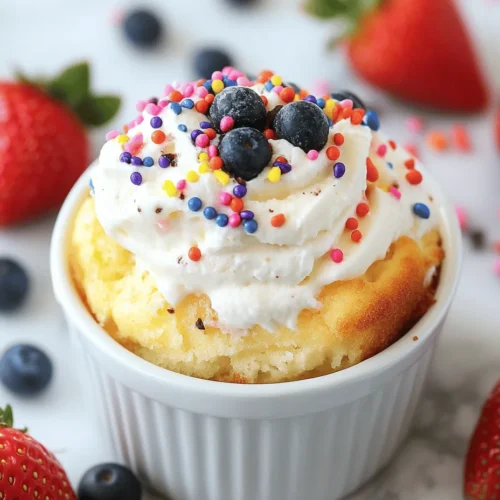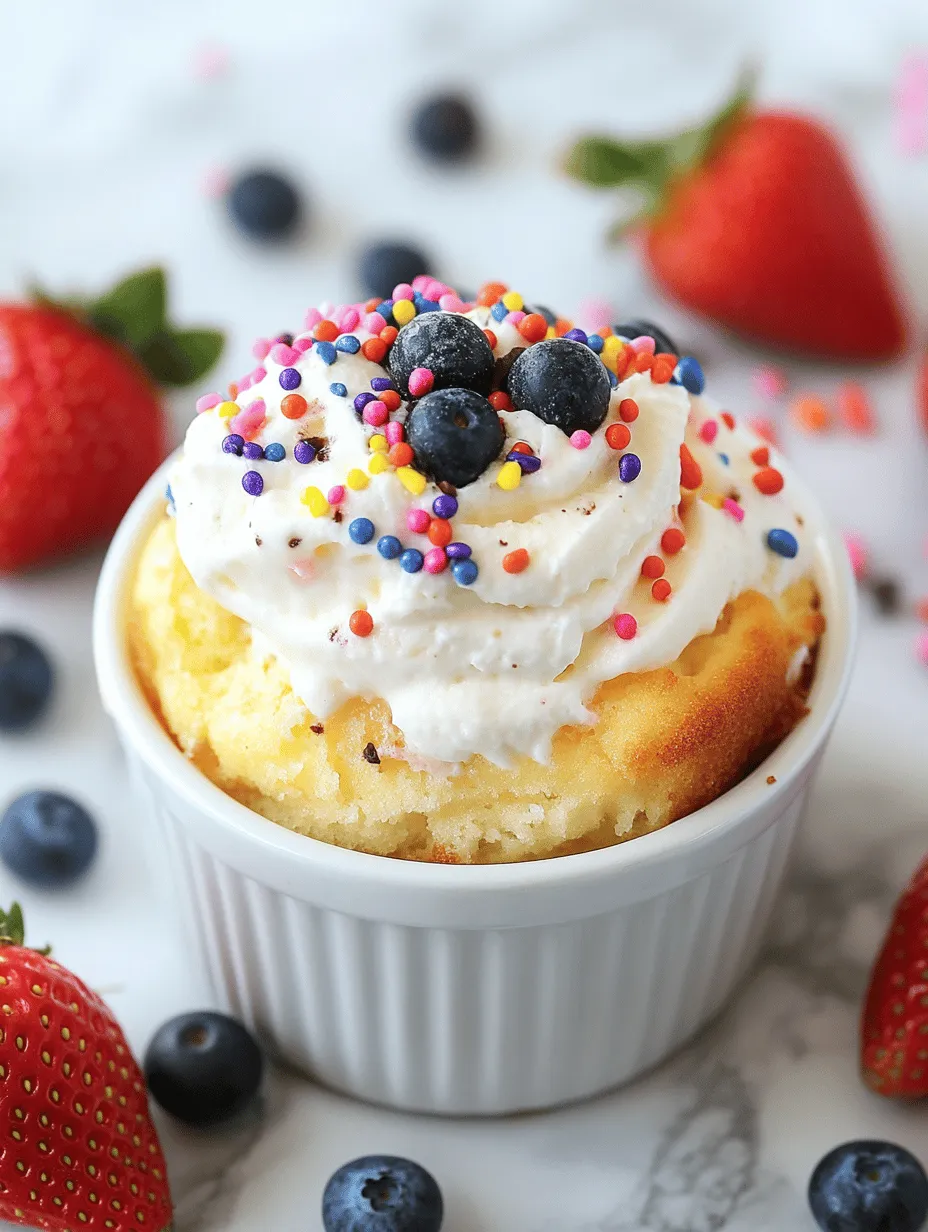In the world of culinary delights, desserts often hold a special place in our hearts. Whether it’s a slice of rich chocolate cake or a scoop of creamy ice cream, desserts are synonymous with indulgence and joy. However, as life becomes busier and our schedules more packed, the allure of a homemade dessert can often feel out of reach. This is where the concept of single-serving desserts shines. The idea of “Sweet Treats for One” is not only convenient but also allows you to savor a delightful, homemade treat without the temptation of excess.
Single-serving desserts have gained immense popularity in recent years, especially among those who seek to enjoy a little sweetness without the commitment of a full cake or batch of cookies. These recipes cater to the desire for instant gratification, allowing you to whip up a delicious treat in a matter of minutes. Easy and quick recipes have become essential in our fast-paced lives, where time is often a luxury. Imagine craving something sweet after a long day and being able to create a delectable dessert tailored just for you, all in under 10 minutes.
The joy of indulging in a homemade treat cannot be overstated. There’s something uniquely satisfying about preparing a dessert in your own kitchen, knowing exactly what goes into it. With a single-serving recipe, you can explore your creativity, experiment with flavors, and customize your dessert to your liking—all without the pressure of sharing. This makes single-serving desserts perfect for those moments when you want to treat yourself, whether it’s after a long day at work or as a special reward on a lazy weekend afternoon.
Understanding the Ingredients: The Foundation of Your Sweet Treats
To create the perfect single-serving dessert, it’s essential to understand the role of each ingredient in your recipe. Each component contributes not only to the flavor but also to the texture and overall experience of your sweet treat. Let’s take a closer look at the key ingredients that make up these delightful desserts.
Flour: The Essential Building Block of Texture
Flour is the backbone of any baked good. In a single-serving dessert, it provides structure and stability, ensuring that your treat maintains its shape during and after cooking. All-purpose flour is often the go-to choice, as it balances protein content and provides a versatile base for various desserts. For a denser texture, consider using cake flour, which has a lower protein content and results in a more tender crumb.
Sugar: Sweetness and Flavor Enhancement
Sugar is not just about sweetness; it plays a crucial role in flavor enhancement and texture. In our single-serving dessert, sugar helps to caramelize and create a beautiful golden crust while also contributing to moisture retention. Granulated sugar is commonly used, but feel free to experiment with alternatives like brown sugar for a deeper flavor or coconut sugar for a healthier option.
Baking Powder: The Secret to a Fluffy Cake
Baking powder is the key ingredient that gives your dessert its lift. It’s a leavening agent that releases carbon dioxide when mixed with wet ingredients and heated, resulting in a light and airy texture. Using the right amount is critical; too little may result in a dense treat, while too much can cause it to rise too quickly and then collapse.
Salt: Balancing Sweetness and Enhancing Flavors
Salt is often an overlooked ingredient in desserts, but it plays a vital role in flavor enhancement. A pinch of salt helps to balance the sweetness of your dessert, making it more palatable. It also brings out the natural flavors of the other ingredients. Always remember to include a small amount, as it can elevate your dessert from good to exceptional.
Milk: Moisture and Richness in Every Bite
Milk adds moisture to your dessert, ensuring that each bite is rich and satisfying. It also contributes to the overall flavor profile, enhancing the sweetness and creaminess of your treat. You can use any type of milk—whole, low-fat, or even plant-based alternatives like almond or oat milk—to suit your dietary preferences.
Vegetable Oil: Keeping Your Dessert Tender
In single-serving desserts, vegetable oil is often preferred over butter due to its ability to keep the treat moist and tender. Oil incorporates easily into batters, leading to a smooth consistency. It is also a healthier option that can provide a lighter texture compared to butter. However, if you prefer the flavor of butter, feel free to substitute it; just remember that the texture might differ slightly.
Vanilla Extract: The Aromatic Touch That Elevates Your Cake
Vanilla extract is a staple in many dessert recipes, and for good reason. Its sweet, floral aroma enhances the overall flavor of your treat, making it more enjoyable. Always opt for pure vanilla extract over imitation for the best results. A little goes a long way, so just a teaspoon is often enough to impart that delightful essence.
Toppings: Exploring the Possibilities for Customization
One of the most exciting aspects of single-serving desserts is the endless possibilities for customization. From whipped cream and fresh fruit to chocolate chips and nuts, the toppings you choose can elevate your dessert and make it uniquely yours. Consider adding a sprinkle of cinnamon for warmth, a drizzle of chocolate sauce for decadence, or a dollop of yogurt for a tangy contrast.
Step-by-Step Instructions: Crafting Your Single Serving Dessert
Now that we have a foundational understanding of the ingredients, it’s time to dive into the step-by-step instructions for crafting your single-serving dessert. This simple process will guide you through preparing, mixing, and cooking your treat with ease and efficiency.
Preparation: Gathering Your Tools and Setting Up
Before you start, gather all your tools and ingredients. This not only streamlines the cooking process but also ensures that you have everything you need at your fingertips. For this recipe, you will need:
– A microwave-safe mug or bowl to cook your dessert
– A mixing spoon or fork for blending ingredients
– Measuring cups and spoons for accuracy
– A microwave for quick cooking
Make sure your workspace is clean and organized, as this will make the process more enjoyable.
Mixing the Dry Ingredients: Achieving the Perfect Blend
Start by combining your dry ingredients in your mug or bowl. Measure out the flour, sugar, baking powder, and salt, and mix them together thoroughly. This step is crucial because it ensures that the leavening agent is evenly distributed throughout the flour mixture, promoting an even rise during cooking. A simple whisk or fork can be used to blend the dry ingredients until well combined.
Combining Wet Ingredients: Tips for a Smooth Batter
Next, it’s time to add the wet ingredients. Create a well in the center of your dry mixture and pour in the milk, vegetable oil, and vanilla extract. Using your mixing spoon or fork, gently stir the mixture until it forms a smooth batter. Be careful not to overmix, as this can lead to a tougher texture. The goal is to combine the ingredients just until you no longer see any dry flour, resulting in a silky batter that will yield a tender dessert.
Pouring and Cooking: Microwave Tips for the Best Results
Once your batter is ready, it’s time to pour it into your prepared mug or bowl. If desired, you can add any mix-ins like chocolate chips or nuts at this stage, folding them gently into the batter. Place your mug in the microwave and cook on high for about 1 to 1.5 minutes. Cooking times may vary depending on your microwave’s wattage, so it’s best to start with a shorter time and check for doneness.
You’ll know your dessert is ready when it has risen and is no longer wet in the center. Be cautious of overcooking, as this can result in a dry texture. If your dessert needs a little more time, microwave in 10-15 second increments until fully cooked.
Cooling and Decorating: Making Your Dessert Visually Appealing
After cooking, allow your dessert to cool for a minute or two before enjoying it. This cooling period not only makes it more palatable but also allows the flavors to meld. Once cooled, consider decorating your treat to enhance its visual appeal. A dusting of powdered sugar, a drizzle of chocolate sauce, or a scoop of ice cream can transform your simple dessert into a stunning presentation.
With these initial steps, you’re well on your way to creating your very own Sweet Treats for One. The combination of understanding the ingredients and following the straightforward instructions will ensure a delightful dessert experience that is both satisfying and easy to prepare. Stay tuned for the next part of this article, where we’ll explore more variations and tips for perfecting your single-serving indulgence.
Exploring the Topping Options: Personalizing Your Sweet Treat
When it comes to desserts, the right toppings can elevate your sweet treat from delightful to downright irresistible. Here’s how you can customize your individual dessert to make it uniquely yours:
Whipped Cream: A Classic Addition for Creaminess
Whipped cream is a timeless topping that adds a light, airy texture to your dessert. Whether you choose to use store-bought or whip it up fresh at home, a dollop of whipped cream can enhance the flavor and presentation of your sweet treat. For a twist, consider flavoring your whipped cream with a splash of vanilla extract, a dash of cocoa powder, or a hint of almond extract. This simple addition not only provides creaminess but also complements the flavors of your dessert beautifully.
Sprinkles: Adding Color and Fun
Sprinkles are a quick and easy way to bring some color and excitement to your dessert. They come in various shapes and sizes, from classic jimmies to themed confetti mixes. Not only do they add a playful touch, but they also provide a delightful crunch that contrasts nicely with the softness of the cake or any creamy toppings. Consider matching the sprinkles to the occasion—pastel colors for spring celebrations or vibrant hues for a birthday treat.
Chocolate Chips: A Rich, Decadent Enhancement
For those who crave a richer dessert, chocolate chips are an excellent choice. Dark, semi-sweet, or even white chocolate chips can provide a decadent touch that makes your sweet treat feel indulgent. You can either fold chocolate chips into the batter before baking or sprinkle them on top just before serving for a melty, gooey experience. Alternatively, try using flavored chips like butterscotch or peanut butter for a unique twist.
Fresh Fruits: Nutritional Benefits and Refreshing Flavors
Adding fresh fruits not only boosts the nutritional profile of your dessert but also introduces refreshing flavors and textures. Slices of strawberries, blueberries, or bananas can complement the sweetness of the cake while providing a contrast in both taste and color. Consider creating a fruit compote by simmering your favorite fruits with a touch of sugar, and drizzle it over your dessert for a gourmet touch. This combination balances indulgence with health, allowing you to enjoy your treat guilt-free.
Creative Combinations: Encouraging Readers to Experiment with Their Favorites
Encouraging creativity in the kitchen is essential when it comes to personalizing your dessert. Don’t hesitate to mix and match your favorite toppings! For example, combine whipped cream with fresh berries and a sprinkle of chocolate chips for a delightful contrast of flavors and textures. Or try a combination of cookie crumbles, caramel sauce, and vanilla ice cream for a truly indulgent experience. The sky’s the limit—let your palate guide you!
Nutritional Information: Understanding What You’re Indulging In
While indulging in sweet treats is a pleasure, being aware of the nutritional content can help you make informed choices. Here’s a breakdown of key nutrients you might find in your individual sweet treat:
Breakdown of Key Nutrients in the Dessert
Typically, a single serving of cake made from our sweet treats recipe provides a good balance of carbohydrates, fats, and proteins. The base ingredients such as flour, sugar, and eggs contribute to the carbohydrate and protein content, while any added toppings can introduce additional fats and sugars. For example, whipped cream adds fats, while fresh fruits offer essential vitamins and minerals.
Considerations for Those with Dietary Restrictions
If you have dietary restrictions, don’t hesitate to modify the recipe to suit your needs. For gluten-free versions, substitute all-purpose flour with almond flour or a gluten-free baking blend. If you’re watching your sugar intake, consider using natural sweeteners like stevia or monk fruit. For dairy-free options, plant-based milk and whipped creams are widely available. These adjustments ensure that everyone can enjoy a delicious dessert without compromising their dietary preferences.
Balancing Indulgence with Health-Conscious Choices
To strike a balance between indulgence and health-conscious choices, consider portion control and ingredient swaps. Enjoying your sweet treat in moderation is key. You can also enhance the recipe with whole grains or by incorporating nuts for added fiber and healthy fats. Remember, enjoying a homemade dessert is not just about the indulgence but also about the joy of creating something delicious for yourself.
The Versatility of Sweet Treats for One: More Than Just a Cake
One of the best aspects of our sweet treats recipe is its versatility. Here are several ways you can adapt the recipe to suit various occasions and preferences:
Alternative Flavors: Experimenting with Different Extracts and Spices
The basic sweet treat recipe serves as a wonderful canvas for flavor experimentation. Consider adding different extracts such as coconut, almond, or peppermint to the batter for a refreshing twist. You can also incorporate spices like cinnamon or nutmeg for a warm, cozy flavor. The beauty of this recipe is that you can easily tailor it to your taste preferences, making it perfect for any time of year.
Seasonal Adaptations: Incorporating Fruits and Flavors Relevant to Each Season
Take advantage of seasonal produce to infuse your sweet treats with fresh flavors. In the spring and summer, try adding zesty citrus or berries. As fall approaches, consider incorporating pumpkin puree and warming spices, or use apples and pears in the winter. Adapting your dessert to reflect the seasons not only enhances flavor but also connects you with the natural rhythms of the year.
Baking in Different Vessels: Exploring Ramekins, Mugs, and Other Options
The versatility of this recipe extends to the vessels you choose for baking. While the original recipe may call for a specific pan, feel free to experiment with ramekins, mugs, or even mini cake pans. Each vessel can create a different texture and appearance, making your dessert feel fresh and unique. For instance, baking in a mug can yield a more cake-like texture, while a ramekin can create a lovely presentation for a mini soufflé.
Transformations: How This Basic Recipe Can Be the Base for Other Desserts
Your sweet treat is not limited to just one form. Consider transforming your basic recipe into various desserts. For example, you could turn your cake into a trifle by layering pieces with whipped cream and fruits. Alternatively, you can bake it as a base for a fruit tart or crumble. This adaptability allows you to explore new culinary creations while still enjoying the simplicity of the original recipe.
Conclusion: Embracing the Joy of Individual Desserts
In conclusion, creating a sweet treat for one is not only about satisfying your sweet tooth but also about embracing the joy of baking. This recipe is simple yet versatile, allowing you to personalize your dessert to suit your tastes and preferences. From whimsical toppings like sprinkles and whipped cream to seasonal adaptations and alternative flavors, the possibilities are endless.
Take this opportunity to enjoy the process of baking and the satisfaction of indulging in a delicious homemade creation. Treat yourself to a moment of joy and creativity in the kitchen, and remember that every bite is a reflection of your unique tastes and a celebration of self-care. So go ahead, whip up your individual dessert, and relish the sweet rewards of your efforts.


